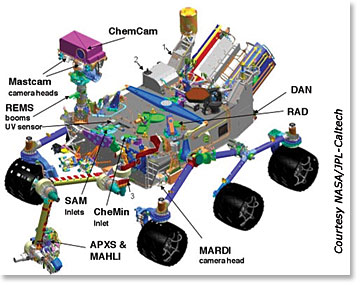Optics on Mars: Building Curiosity Instruments
After a 36-week flight, the Mars rover Curiosity landed squarely at its destination 5 August inside Gale Crater on the Red Planet. NASA’s most advanced Mars rover will spend two years gathering information on geology, atmosphere, and environment and trying to discover if Mars ever had environmental conditions that could sustain microbial life.
About the size of a small SUV, Curiosity is crowded with state-of-the-art cameras, spectrophotometers, radiation detectors, lasers, and sensors.

Many of these devices showcase the latest in optics and photonics technologies and were developed or manufactured by SPIE corporate members and exhibitors at SPIE events.
• Optimax (USA) provided several of Curiosity’s optics, utilized by the rover’s cameras and in-situ instrumentation.
• The rover is equipped with three modular HR2000 high-resolution miniature fiber optic spectrometers from Ocean Optics (USA). Part of the Chemistry & Camera (ChemCam), these instruments are studying Martian rock and soil composition.
• Imaging sensors from e2v (UK) are located on the ChemCam and the Chemistry and Mineralogy instrument (CheMin). NASA’s Mars Reconnaissance Orbiter carried e2v imaging sensors, which captured an image of the Mars rover as it parachuted to the planet’s surface.
• The CheMin is an x-ray diffraction-capable mineralogy instrument for detecting the presence of water in the Martian rocks and soil. Samples gathered in the tunable sample cells must be shaken at variable amplitudes and frequencies. These controlled vibrations are generated by PI Ceramic (Germany) monolithic piezo actuators. PI miCos (Germany) also equipped the ChemCam with a precision motorized positioning stage. The two companies are part of the PI Physik Instrumente (USA) family of companies.
Several SPIE conference exhibitors also have instruments aboard Curiosity.
The ChemCam contains laser diodes from 3S Photonics (France) and a plasma-producing Q-switched, diode-pumped solid-state laser from Thales Laser (France). Charge-coupled device (CCD) cameras from Teledyne Dalsa (Canada) aid in navigation and hazard avoidance. For its trip to Mars, Curiosity was powered by radiation-hardened photovoltaic cells from Emcore (USA).
Curiosity’s x-ray spectrometer, a laser-induced-breakdown spectroscopy system, organic-sample-analysis systems, and radiation- and neutrino-detection systems were built by BAE Systems’ U.S. subsidiary. Ball Aerospace (USA) built the High Resolution Imaging Science Experiment (HiRISE) camera to record the rover as it descended toward the landing site, still connected to its parachute.
The first images sent from Curiosity were taken with lens assemblies from Rockwell Collins (USA). The lens assemblies include eight Hazcams used to detect obstacles in Curiosity’s path and generate 3D images to plan motion of the rover’s robotic arm. Rockwell Collins also made four Navcams to provide broadview, black-and-white images of the Martian landscape.
Other institutions contributing to the Mars Curiosity mission include:
- The National Centre for Space Studies (CNES), the National Centre for Scientific Research (CNRS), and Paul Sabatier University, all of France, which developed several instruments aboard the Sample Analysis at Mars (SAM) instrument suite. SAM makes up more than half the science payload on Curiosity and is exploring molecular and elemental chemistry relevant to life by analyzing atmospheric and solid samples.
- The Radiation Assessment Detector (RAD) was developed by the German Aerospace Center (DLR) and the University of Kiel (Germany) to assess the amount of radiation on the planet and how radiation might affect potential life.
- Malin Space Science Systems (USA) supplied three of Curiosity’s imaging systems, the Mars Descent Imager (MARDI), which beamed back to Earth amazing video of the rover’s safe landing on the planet; the Mars Hand Lens Imager (MAHLI), which acquires close-up views of the Gale Crater; and the Mastcams that are taking 3D images. (SPIE Newsroom visited Malin Space Science Systems (USA), suppliers of three Curiosity’s cameras. See the video at spie.org/malin)
- Before any physical prototypes of Curiosity were built, product lifecycle management software from Siemens AG (Germany) was used to digitally build and simulate the rover.
- Sensitec (Germany) developed the magnetoresistive sensors that monitor critical parts of the rover, such as the wheels, camera masts, and antennae.
Whatever the outcome of this mission, these innovative photonics companies, along with several others not mentioned here, are helping advance our knowledge of Mars and the solar system.
Have a question or comment about this article? Write to us at spieprofessional@spie.org.
To receive a print copy of SPIE Professional, the SPIE member magazine, become an SPIE member.



